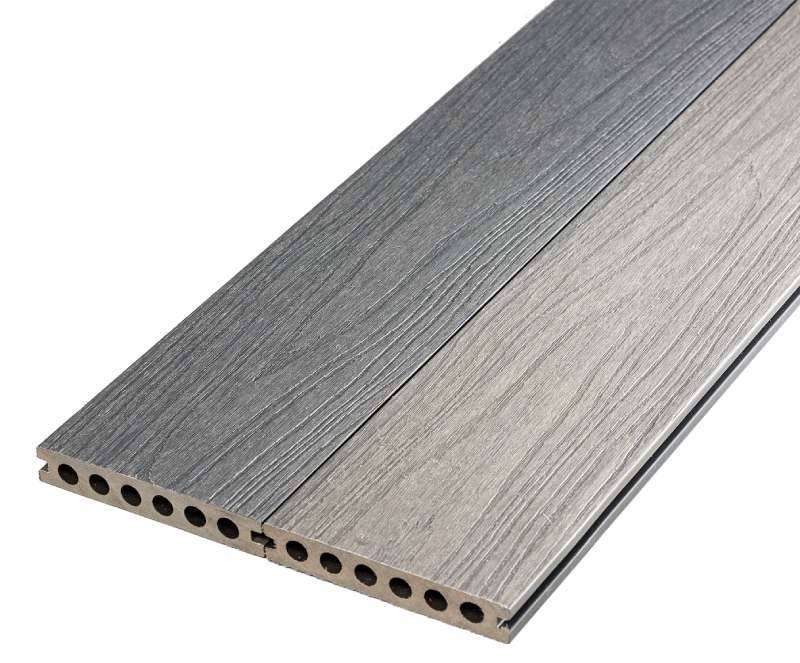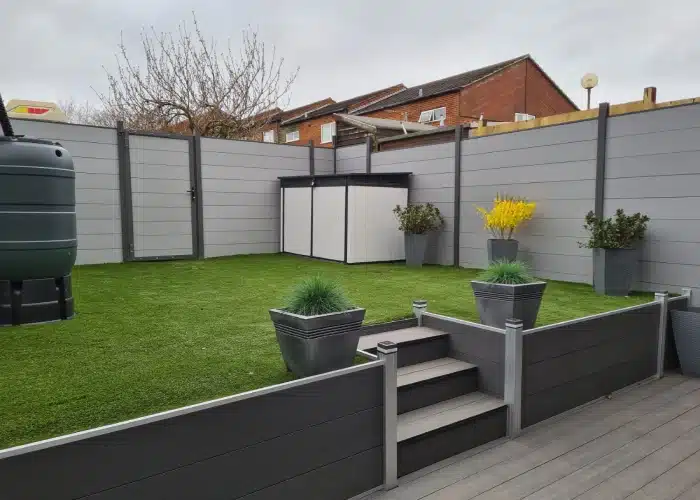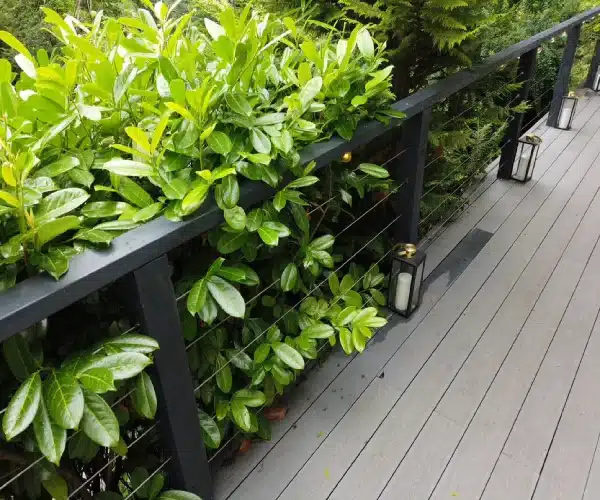Does Composite Fencing Add Value?
Capped Composite Decking
Capped composite decking is sometimes referred to as a shielded or Co-Extrusion. Some may also refer to capped composite decking as 2nd generation. The capping refers to an additional plastic layer wrapped around the entire outer part of the decking board. This plastic PE layer increases the boards resistance to water, stains and UV rays, increasing the boards many benefits when compared to wood and uncapped composite boards. There are two types of composite decking, capped and uncapped. So, what are uncapped boards.

As the name suggests, uncapped composite decking does not benefit from an additional protective layer. The surface layer is made from wood fibres. They have lower water resistance, but since it’s made from plastic and wood, they will not absorb water as easily as timber decking.
Capped or shielded composite decking in relation to water, absorbs less than 1% in test results, this not only makes capped composite decking great for installation in moist humid areas but its a key feature in stain resistant performance too, due to its PE layer many liquids, oil and greasy food don’t soak into the surface like wood or uncapped boards do, meaning they can be simply wiped away.
Capped composite boards do come in different designs and these designs can change alter the boards performance over time, so what are the types of capped boards, below we will take a look.
Type of Capped Composite Decking
There are different second generation composite boards. Remember that capped composite decking has an extra layer of plastic on its outside.
There is one side capped decking that has an extra plastic coating on one side of the board. The coating is always on the part that faces up after installation. Its key to note that some people in the sector also refer to one side capped, as half capped.
Two sides capped decking has a plastic coating on the top and bottom of the board, but not in the middle normally where the groove is, why? this helps lower production costs during manufacturing.
Fully capped or wrapped this is a composite decking board with the whole sides capped. This type of capped composite decking is the best as moisture or water will not be able to infiltrate the board.
One and two sides capped have been known to perform differently to fully capped composite decking boards, this is due to moisture absorption as the sides are exposed and absorb water at different rates. The PE layer increases the boards water resistant, this means the sides without the PE layer will absorb water at different rates and levels, due to this we have seen boards alters mainly creating a cupping effect after many years. So, we would only recommended fully capped and this is why we only sell full capped.
Advantages of Capped Composite Decking
Resistant to Moisture
Capped composite boards will not swell like wood. It is the best type of composite decking to install to prevent any chance of moisture from getting to the board. If you plan to install decking around your swimming pool or hot tub, the recommendation would be to choose capped boards, in particular full-capped decking boards, due to there increased resistant and stability against moisture, they simply outperform and outlast wood and even uncapped boards in wet conditions.
Long-lasting Colour
Capped boards perform in colour consistency and longevity, put simply they outperform wood and uncapped boards when it comes to retaining there original colour. Wooden decking as we know will fade and it requires regular staining or painting to maintain the decks appearance. Uncapped composite boards will also fade losing on average 30% of colour.
Capped composite decking records a delta E of 1.8 after 100s hour of consist UV rays, delta E may sound technical, but, put simply its the measure of the change in colour. Anything with a Delta E of 2 or below the human eye doesn’t see any visual change. Meaning capped composite boards are years of UV rays and being outdoor are going to retain and maintain its original colour for longer compared to wood or uncapped decking.
Stain Resistant
Stains on decking a common drawback to wood and uncapped boards, liquids or common BBQ food can be soaked up on your deck leaving unsightly stains that are either permanent or need a lot of elbow grease to remove.
If you and your family are active outdoors then this will be an issue and something you will want to avoid or even protect against.
Capped boards offer excellent stain resistance, we have ran many test on our signature capped range. We have left ketchup, beer, red wine and rust on our capped composite decking for over 24 hours with no visual colour change at all. We have even taken steps further leaving vinegar on the board for over 24 hours and again no colour change.
Capped composite decking is perfect for an active and large families looking to add extra protect on there decking against common stains.
Mould & Mildew Resistant
Mould and mildew is common on wooden decking if not maintained correctly, mould and mildew can stain, increase risk of slip and rot wooden decking. Mould can also create issue for uncapped composite too, if its not maintained correctly, as uncapped composite boards are made from a wood based surface, dirt, debris and water left for long periods become a breeding ground for mould and this can become present in uncapped boards, this is why regular cleaning is key.
Capped boards as mentioned absorb minimal amounts of water, moisture and water are key for mould to breed, due to its PE layer and low moisture absorption, this helps capped composite decking to keep mould and mildew at bay, in turn offers resistance to mould and mildew, but you must keep your capped boards clean to ensure mould doesn’t grow on the boards, grease, dirt, water and debris left for prolonged periods will attract mould even on capped boards. So keep you deck clean regularly and this is something you wont have to worry about.
Scratch Resistant
Composite decking is prone to scratches. Children’s toys, pets, furniture and BBQ’s can scratch the surface of your decking. Capped decking board offers some scratch resistance with its additional plastic coating, but in all honestly small amounts. Capped composite decking is not scratch-proof and extra care most to taken when moving heavy materials or furniture on your deck.
Tips and advice on how to avoid scratches on your composite decking can be found here.
Conclusion
Capped composite decking has an additional layer of plastic on its surface. This provides high resistance to moisture, stains and improved colour fade protection from harmful UV rays.
In addition full capped boards, simply outperform and outlast wood and even uncapped boards in wet condition. They are the ultra low maintenance decking solution, lasting for years in durability and appearance with regular cleaning.
Is Composite Decking Maintenance Free?




